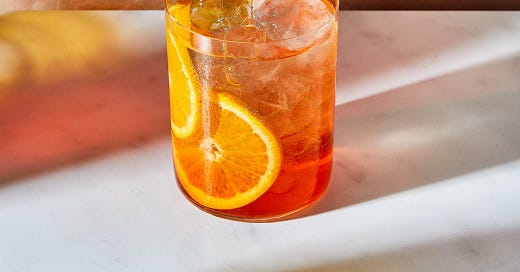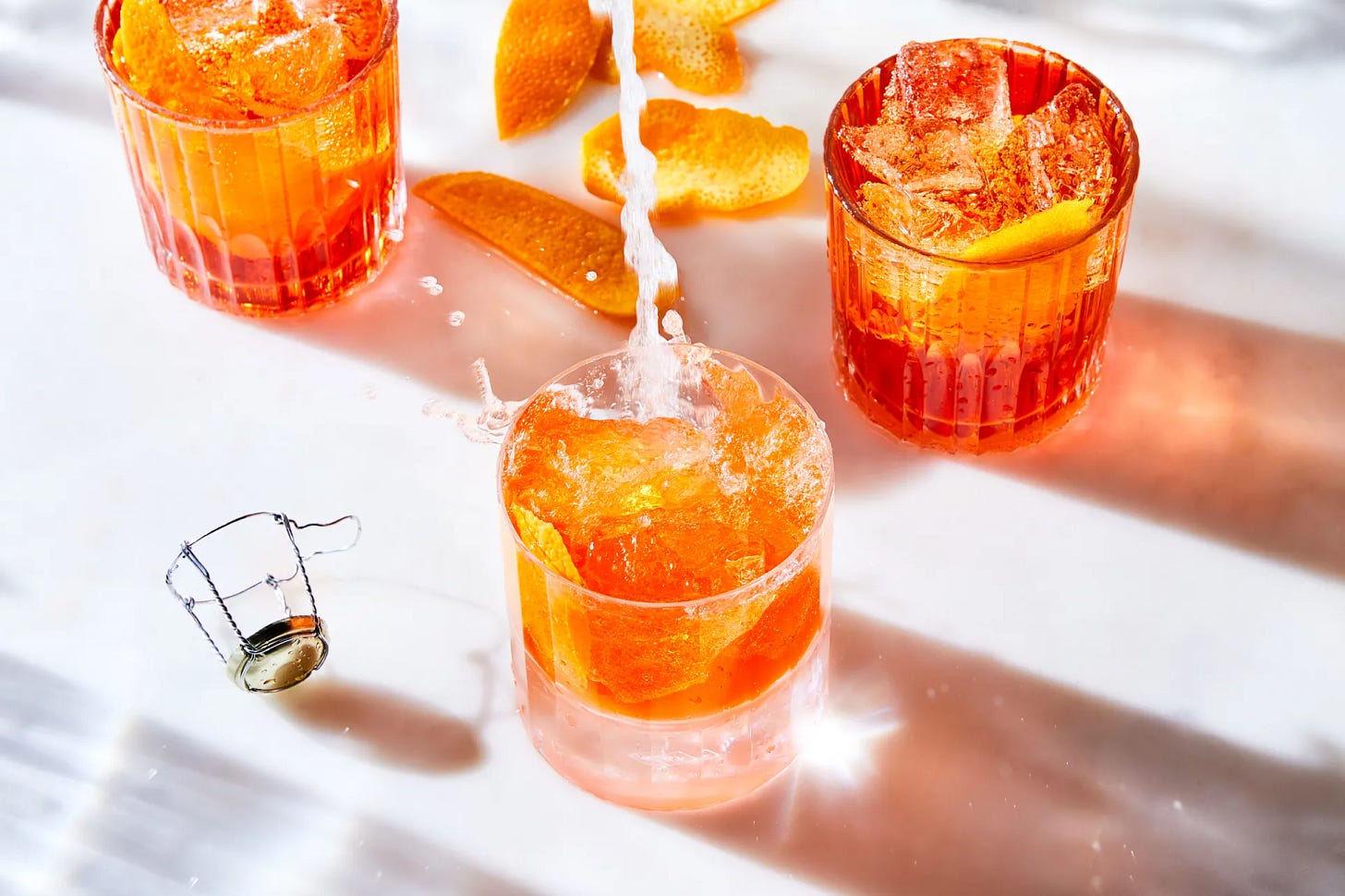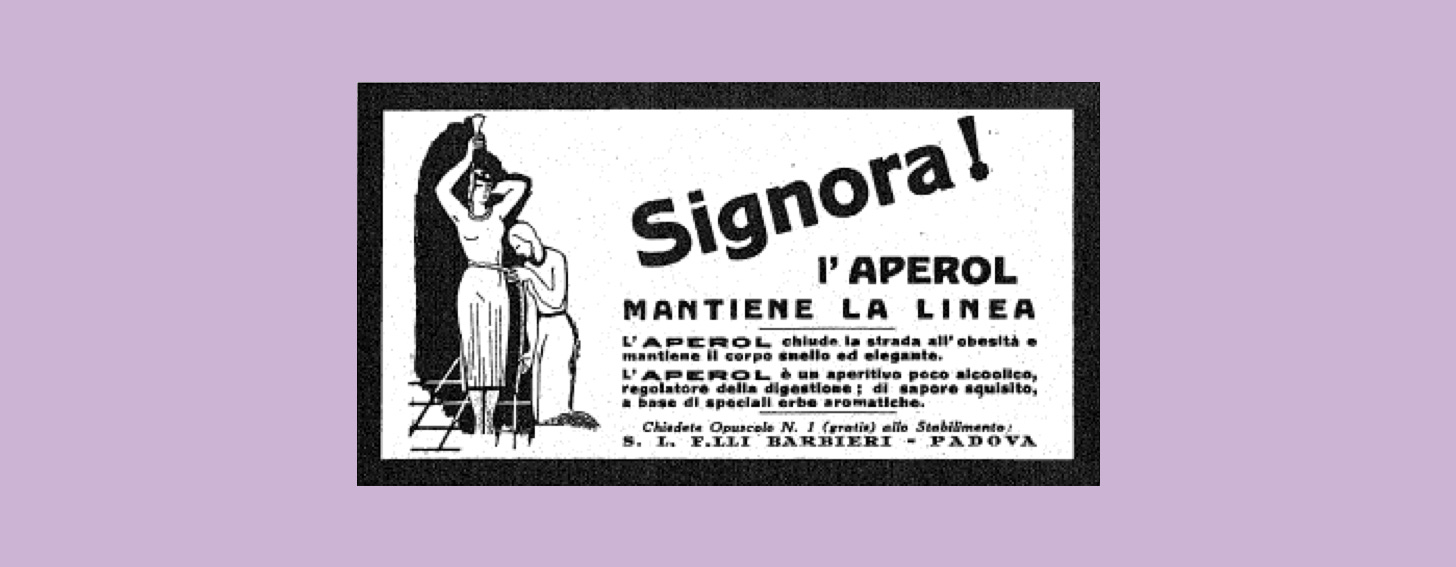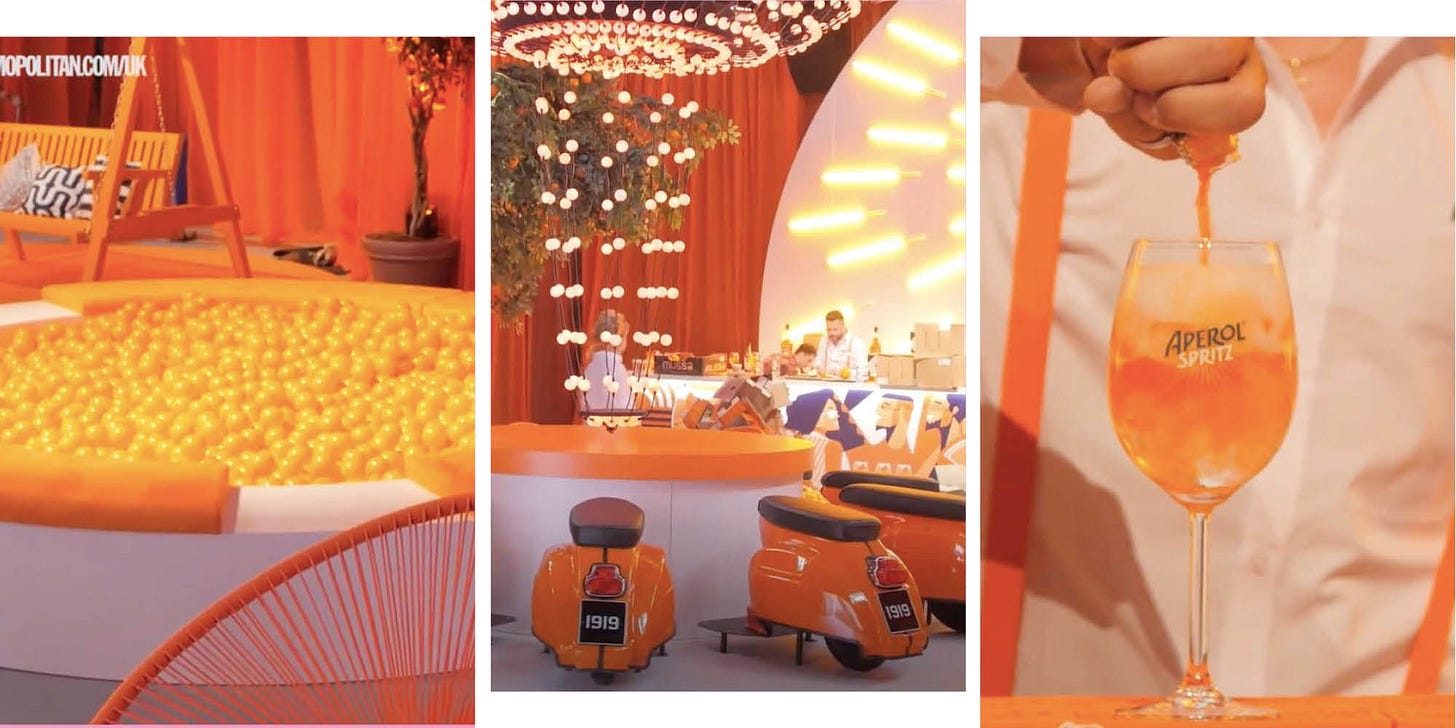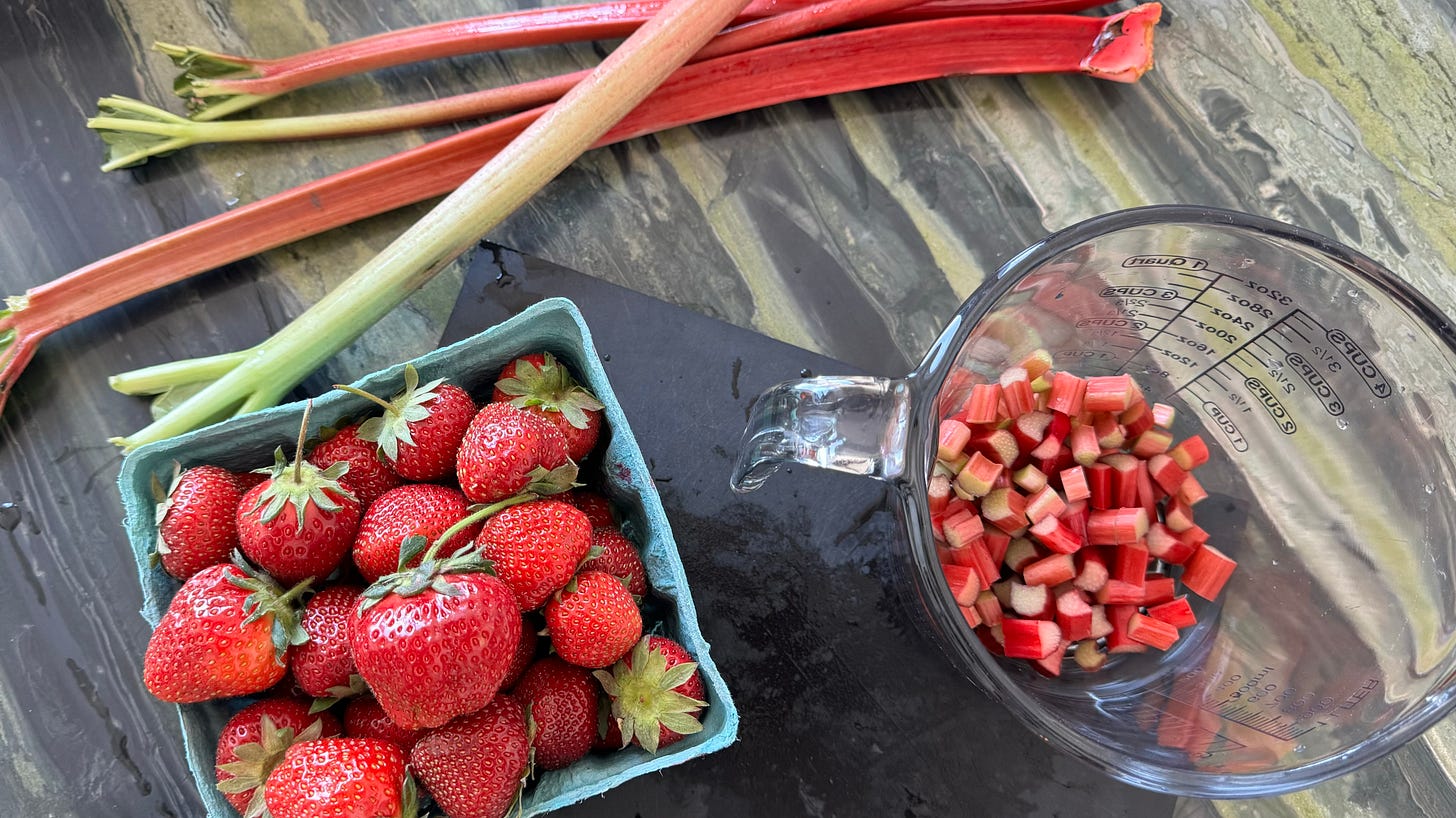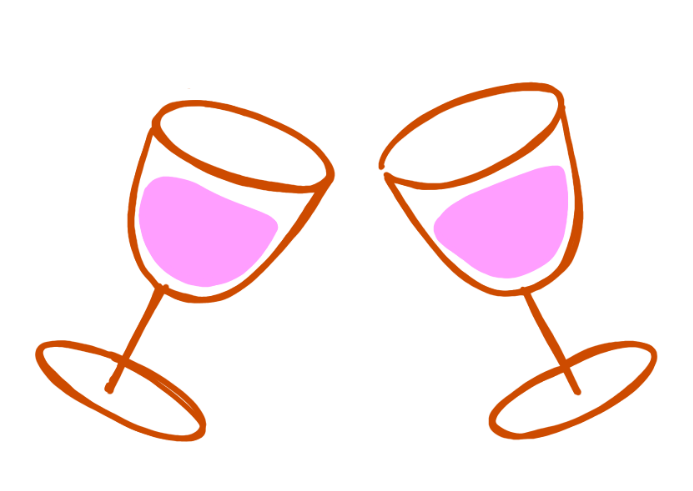Happy spritz season, for those who celebrate
🍊 Kicking off a new series with a quick history of this classic cocktail
When I started this newsletter (over a year ago?!) I named it The Spritz because of the feeling it conveys, you know, ✨ the vibes ✨. It’s light, refreshing, and simple. There might be more complex options out there, ones that really make you think. But sometimes you just want to sit in the sun with a perfectly bubbly, bittersweet drink.
But, while the name is more emotive than descriptive, I do also happen to truly love a good spritz. Doesn’t matter the season, the weather, or the activity, I’m there. And we aren’t just talking Aperol here — that’s far too limiting! I can’t get onboard with everyone saying the Aperol Spritz is ‘bad’….have you had one lately? Still delicious. But variety is the spice of life and the spritz might be the perfect canvas for experimentation.
There is a seemingly endless supply of ingredients to explore; from classic aperitivo, alpine amaros, and regional vermouths, to more modern domestic examples from places like NY and California. And unlike other classic cocktails, the measurements aren’t exact, so it’s really about experimenting to find your own favorite flavors and combinations.
Since summer is officially spritz season, I thought we could do a new series seeing how far we can push this classic drink. Alongside some fun research into the history and branding of aperitifs, amaros, and vermouths. But before we dive into that, a quick history! It’s more interesting than you might think.
History of the spritz
When the Napoleonic Empire collapsed in 1815, it left a power vacuum of remaining superpowers fighting to occupy the land previously occupied by French forces. Italy’s northern regions, including Lombardy and Venetia, were assumed by the Austrian Habsburg Empire. The Austrian soldiers, more accustomed to lighter, less alcoholic wines and beer, found the bold Italian wines to be a difficult adjustment. I guess that’s what happens when you only drink riesling (overachievers will remember that riesling is very low ABV due to the cold weather).
To make the strong wines more palatable, they began diluting them with a spray of water, calling it ‘ein Spritzer,’ meaning ‘splash’ or ‘spray’ in German. Despite the initial horror from Italians — one can only assume based on the pride Italians have for their traditions — this habit remained even after Italy gained it’s independence later in the nineteenth century.
The idea to use the local sparkling wine, Prosecco, instead of wine and mixing it with a bitter liqueur actually came much later.
And what about Aperol?
To start, it’s important to know that a spritz is considered an aperitif — a lower alcohol drink consumed before a meal to stimulate the appetite. In Italy, a spritz is a style of cocktail, ranging widely from region to region. Different local bars will even put their own spin on the classic formula, making something truly special and unique.
Aperol, now by far the most popular aperitif around the world, wasn’t even invented until the early 1900’s. Much later than the invention of the spritz! After years of experimentation in their father's distillery, two brothers, Luigi and Silvio Barbieri, perfected their aperitif made from sour orange peels, gentian root, rhubarb and spices. It was first advertised in the 1920’s to drinkers who wanted to stay fit because of its low alcohol level (just 11%), and especially to women with the slogan, "Signora! Aperol keeps you thin". This is definitely a diet I could get on board with.
Beyond just Aperol, bitter, fortified liqueurs really took over in Italy in the 1920’s, making the jump from medicinal beverages to social refreshments.
It’s affordability and ubiquity meant that an Aperol Spritz quickly became the drink of choice for rowdy old men and poor college students in the Veneto region. Served in durable rocks glasses and plastic cups, it was the perfect drink for staying out late and catching up with friends in the piazzas. In the early 2000’s, Campari Group purchased Aperol and began serving it in an elegant, tall balloon-shaped glass instead of the rock tumbler of the osteria — a clever marketing play that quickly helped commercialize the drink. The target audience quickly became the more affluent, fashion conscious crowd in cities like Milan. Aperol’s color and taste give it an easy appeal. It's the color of the summer evening, you think Aperol Spritz and immediately imagine yourself on a terrace at sunset overlooking the Adriatic Sea.


Aperol can be credited with the resurgence of bitter cocktails in the US - or really bitterness in general. 40 years ago, Americans rarely went for dark chocolate, kale, coffee. Now you can’t find a bar without some version of a Negroni on the menu.
How it’s made
Aperol is made by infusing a neutral base spirit with bitter and sweet oranges, rhubarb, quinine and gentian (plus many other herbs and roots). The blend is then filtered, sweetened with sugar, and cut with water before bottling.
Aperol Spritz critics often cite it’s intense sweetness and bold citrusy punch, saying it lacks the complexity of other liqueurs. But analyzing the Aperol Spritz misses the whole point. This cocktail is all about easy enjoyment and accessible pleasure — La Dolce Vita — the relaxed and carefree lifestyle that flourished in Italy’s cities during the 1950s. The beauty of the Aperol Spritz is in its simplicity; it’s not pretending to be a complex drink. There are enough complex drinks out there.
Now, if you want to critique the insane marketing budget of Aperol in recent years, that’s something I can get on board with!
Classic spritz formula
Just remember 3:2:1! But also remember not to overthink it — I have never once measured the ingredients for a spritz. Feel free to eyeball it 👀
3 parts Prosecco (Or Cava, just make sure you get something dry. And don’t bother spending much here!)
2 parts Aperol
1 part Soda water
Ice
Orange slice or olive
I always start with the Prosecco because I find that the bubbles help naturally mix everything together.
I love experimenting with riffs on this classic drink so stay tuned for more fun recipes in the coming weeks. And of course I will be including a roundup of vintage liqueur ads with each recipe — what an era for poster design!
I’m perfecting a 🍓Strawberry Rhubarb Lillet Spritz🍓 recipe that you will not want to miss. And I bet your friends will like it too….so do them a favor and forward this newsletter along!


